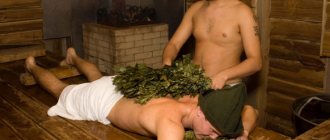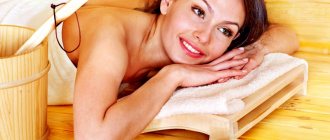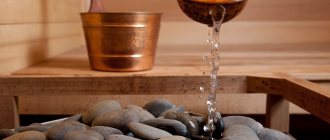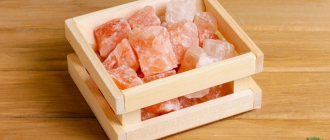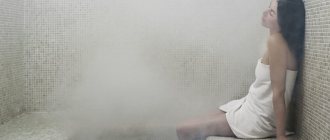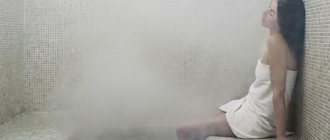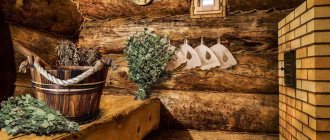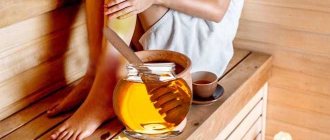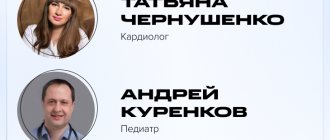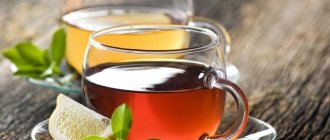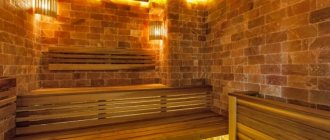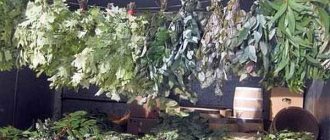What are the benefits of massage in a steam room?
Bath massage, performed using various techniques, provides relaxation of the muscle corset, improves the mobility and elasticity of the ligaments. It helps eliminate pain, swelling, relieve tension and fatigue, and restore after exhausting physical and emotional stress.
In general, this procedure has a beneficial effect on blood circulation, blood vessels, heart, lungs and skin.
The influence of high temperatures and high humidity leads to an acceleration of metabolic processes in the human body. As a result, lymph flow and blood circulation improve, sweat production accelerates, the skin cleanses, and muscles and joints acquire the necessary elasticity and mobility.
A light bath massage has a beneficial effect not only on the appearance, but also on all internal organs through acupuncture points located on the human body. Proper treatment of each point contributes to the health of the internal organ for whose work it is responsible.
Such procedures are an effective means in the fight against excess weight and cellulite.
Peeling in the bath - complete cleansing
To better clean the upper layers of the epidermis and give the skin elasticity and firmness during spa steaming, peeling procedures with special scrubs are often performed. You can buy cosmetics in a store or make your own. A good natural scrub is considered to be a mixture of honey, sugar, oatmeal, ground coffee, table salt and soda. It is customary to add a little shampoo or shower gel to the peeling mixture in the bath, which will soften the mixture a little and it will not scratch the skin too much. Peeling is done after steaming; peeling can be done after a bath.
So that the scrub can not only perform a cleansing function, but also help nourish and moisturize the skin, you should add a few drops of essential oil to it. Wheat germ oil, cocoa oil, jojoba oil, and coconut oil nourishes the skin and makes its surface velvety. Citrus essential oils help fight cellulite. Also, face and body masks made from different types of clay are effective for facial skin: blue, red and pink clay are suitable for dry skin, blue, white and green are suitable for oily skin, and black clay from the Dead Sea is an excellent choice for sensitive skin and those prone to rashes. .
Are there any contraindications to massage?
Without a doubt, massage in a bathhouse is a very useful and effective practice of bathing leisure, but it has some contraindications.
Such procedures are not recommended if you have:
- epilepsy;
- serious heart pathologies;
- problems with blood circulation;
- oncology;
- benign neoplasms;
- pathologies of the liver and kidneys;
- fungal diseases;
- tuberculosis;
- AIDS and HIV infection.
You should avoid visiting a steam room with a massage in the following cases:
- alcohol and drug intoxication;
- nausea and vomiting;
- high temperature;
- internal bleeding;
- allergic reactions;
- influenza and acute respiratory viral infections;
- postoperative recovery;
- pregnancy and breastfeeding.
If there are no problems with well-being and health, then visiting a steam room is the best way to relax and improve your health.
Massage after the bath
When visiting a bathhouse, there are many ways to improve its effect. And one of the most powerful methods is massage. It was initially recognized as an excellent means of relaxation, but when a visit to the bathhouse is added, the effect becomes amazing.
There are three types of bath massage:
- before visiting the steam room
- directly in the steam room
- massage after the bath
In this case, massage before the bath is practically not used. The reason is that the main requirement of massage is to accelerate blood flow, which is not very good before a steam room. Therefore, only light preparatory work is carried out before the bath.
In the steam room, massage is carried out using tools, namely a broom. Stroking the skin with leaves, lightly patting, building up heat, releasing beneficial substances that are absorbed through the pores - all this is an excellent relaxing, tonic, healing massage. However, the most effective massage is after a bath.
The main feature of a massage after a bath is the increased absorption of any beneficial substances.
At high temperatures, the pores expand. Therefore, massage is carried out using various creams. The classic Russian version is a honey-based cream, which is quite easy to get today. Honey is a unique product containing a huge amount of vitamins and nutrients. In addition, honey is considered a cleansing product. It not only supplies the skin with vitamins, but also rids the body of toxins. With proper massage, you can notice how a white mass appears on the body; this is the body getting rid of toxins. At the same time, the cleansing effect is especially noticeable due to the enlarged pores after the steam room.
In addition to honey, any other natural-based creams are used for massage. The massage after the bath should not be intense, the body has already suffered heavy loads after visiting the steam room, is it worth aggravating them?
It is best to carry out relaxing massages with rubbing and light patting. Contraindications for massage are, in principle, the same as for a bath. That is, massages are not recommended for diseases of the blood, cardiovascular system, thrombosis, varicose veins, fever, inflammatory, purulent processes, etc. This also includes individual allergies to certain components of creams.
Also, after the bath, you can perform another type of massage that does not use creams. This is a cupping (vacuum) massage. It is recommended for losing weight, restoring blood flow, and improving the condition of the entire body. Moreover, all types of massage are carried out after visiting the steam room. Before the massage, you need to take a warm shower, thoroughly washing off the sweat.
Types of bath massage
There are several effective methods of bath massage aimed at healing, strengthening the body and improving well-being. One type of procedure is designed to warm up muscle mass, another to relieve tension, and a third to improve appearance.
The most common techniques include the following types of massage:
- classical;
- self-massage;
- with bath brooms;
- honey;
- health;
- foamy.
The choice of the appropriate technique is determined by individual preferences and the therapeutic effect that is planned to be achieved.
Classical
A similar technique is used after preliminary preparation of the body, when the muscle corset and skin are warmed up as much as possible. Many bathhouse attendants carry out the procedure in a steam room, although the most suitable place is considered to be a slightly cooled room, for example, a relaxation room or a dressing room.
Classic massage uses techniques such as:
- stroking;
- trituration;
- kneading;
- stretching;
- push-ups;
- clapping;
- blows;
- vibrations.
Proper alternation of techniques promotes rapid relaxation of the body and accumulation of internal energy. All movements are performed in the direction of lymph and blood flow from the heart to the extremities.
The duration of the procedure is from 10 to 25 minutes.
Independent
If a massage therapist is required to perform other types, then this technique can be mastered independently. It is especially suitable for those who prefer to steam in a sauna alone.
Self-massage is carried out after thoroughly warming up the body in a warm room, and uses a small number of effective techniques:
- squeezing the skin with slight pressure;
- rubbing muscles and joints with fingers or fists;
- kneading, patting and tapping with palms or fists.
All techniques are performed 3 times and alternate with each other. The duration of the procedure is from 5 to 15 minutes.
With brooms
Another popular technique is massage in a bathhouse with a broom. When heated, fragrant brooms release volatile substances into the air that have a beneficial effect on the respiratory system. Phytoncides, which are contained in the leaves and stems of plants, disinfect the skin, promote its regeneration and rejuvenation.
Most often, dense brooms made from birch and oak branches are used. Before the procedure begins, the ligaments are thoroughly moistened in warm water, and the body is cleansed of sweat and warmed up.
Massage movements should be light and soft, first stroking and kneading, then patting and tapping, and finally rubbing and stretching.
To obtain a healing effect, it is necessary to work out every part of the body, starting from the limbs, moving to the legs, buttocks and back.
The duration of the procedure is from 5 to 30 minutes.
Honey
Another effective type of procedure for women is honey massage. It helps relieve bronchitis, dry cough, pain in the legs and lower back.
Before the procedure, it is important to properly prepare the body. For this purpose, use a warm shower, contrast dousing and dry heat.
Then a thin layer of honey mixture is applied to clean skin and left for 7 minutes. Next, use your palms to make circular movements with intense pinching of the skin, which helps improve blood circulation and gently cleanse the pores. The massage technique is performed until the honey mixture stops sticking to your hands and acquires a characteristic gray tint. After completing the procedure, the honey is thoroughly washed off with warm water.
The duration of the massage is from 5 to 15 minutes.
Wellness
Massage is practiced using natural healing and cosmetic products. For spa treatments, mud, stones, honey-salt mixture, clay, and aromatic oils are used. Each product has a beneficial effect on the human body.
The main purpose of a healing massage is to strengthen the immune system, improve well-being and rejuvenate the body.
The duration of the procedure is from 10 to 20 minutes.
Basic oil massage techniques
When performing an oil massage, you need to learn a number of techniques. In addition, the massage therapist must have a good knowledge of the structure of the human body, especially the spine. He must feel with what force the massage should be performed in each specific case.
Oil massage requires knowledge of four basic massage movements: patting, kneading, rubbing, squeezing.
Oil massage begins with patting, gradually moving to kneading, then proceeds to thoroughly rubbing the body. Finish the oil massage with a series of squeezing movements on the limbs.
Patting increases blood circulation, strengthens muscles, and activates the body's defenses. Performed with palms cupped.
Kneading - relaxes muscles, joints, ligaments, relieves tension, promotes tissue rejuvenation. The technique is performed until the body under your hands begins to resemble well-kneaded dough in its condition (by the way, it is best to train your hands for massage on the dough).
Rubbing - improves blood circulation, lymph circulation, improves skin nutrition. Dry rubbing relieves muscle tension. Rubbing with oil improves joint mobility and promotes uniform heat distribution throughout the body. Light rubbing movements relax. Intense rubbing is stimulating. You need to start with light rubbing, gradually increasing the intensity of movements.
Compression - stimulates the network of the finest nerve endings, increases the flow of nutrients. Compressive movements are performed on the limbs, fingers and toes. The technique begins to be performed from the hip or, respectively, from the shoulder, gradually moving to the toes or fingers. The phalanges of the fingers and toes are twisted alternately in both directions.
